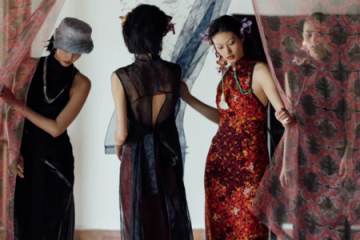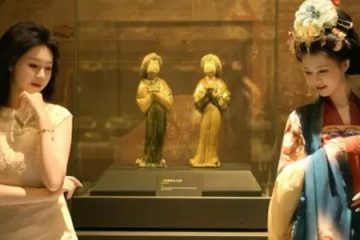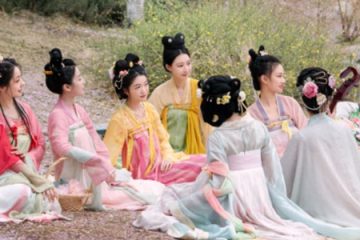Eastern Aesthetics Go Global — Hanfu Is Truly on Its Way!

From June 12 to 13, the “Fashion China: Glory of the East – 2025 China Fashion Industry Gala” was held in Shanghai. During the event, Tian Qinxin, Director of the National Theatre of China, delivered a keynote speech titled “The Fashion Awakening of Chinese Aesthetics.”
Her words truly inspired the team at SilkDivas. It made us realize that a love for Chinese-style aesthetics is far from niche. Beyond Hanfu, various expressions of Eastern aesthetics are gaining increasing popularity worldwide. Major international fashion houses are embracing the “Oriental vibe,” and on platforms like TikTok and Instagram, hashtags such as #Hanfu, #EastAsianAesthetics, #QinghuaStyle, #WabiSabi, and #OrientalFashion have collectively attracted tens of millions of views—hard data that speaks for itself.
Ⅰ. A Cultural Awakening Behind the Rise of Eastern Aesthetics
For much of the 20th century, China looked to the West for fashion and design inspiration. But in the past decade or so, driven by a national call to revive traditional Chinese culture, a renewed sense of cultural confidence has surged across many industries.
As Tian Qinxin put it:
“This awakening has brought China’s fashion and art practices back to their Eastern roots. More and more designers are drawing from the elegance of the Han and Tang dynasties, the refinement of the Song and Ming. The mamian skirt now walks international runways, verdant landscape paintings are reimagined as stage designs, and tradition is no longer a static symbol—it flows through the veins of contemporary creativity.

Chinese designers are now featured in haute couture shows in Paris. Even traditional Chinese joinery inspires fashion pieces that captivate global audiences. Chinese culture, with all its rich splendor, is reshaping the boundaries of global fashion like never before.”
Since Hanfu first captured public attention, its popularity has never waned. While the rise of cultural confidence plays a big role, what truly sustains Hanfu’s appeal is its deep cultural value. Every sleeve, every pleat, reflects centuries of wisdom and craftsmanship. Hanfu is not just clothing—it’s the crystallization of thousands of years of Chinese civilization, refined and proven through time. Its enduring quality and intricate design are proof of the intelligence and aesthetic sensibility of our ancestors.
II. Timeless Wisdom Woven into Hanfu
1. Heaven is Round, Earth is Square
In ancient Chinese cosmology, the universe was believed to follow the principle of “Heaven is round, Earth is square”—a worldview recorded in classical texts like Zhoubi Suanjing and Huainanzi. This philosophy is subtly reflected in the design of traditional Hanfu:
Round collars and square-cut bodies: The curved neckline of the cross-collar Chinese outfit symbolizes the heavens, while the square sleeves and hems represent the earth. The combination of these shapes reflects the harmonious balance between heaven and earth—what Chinese culture calls “the unity of heaven and humanity.”
Imperial robes follow the same logic: The round crown and square lower garment of the emperor’s ceremonial attire (mianfu) perfectly embody the “round above, square below” structure, signifying that the ruler governs the world under the mandate of heaven.

2. Balance and Symmetry
Symmetry is a defining feature of Hanfu design, seen in collars, sleeves, patterns, and waistbands—all meticulously aligned along a central axis. This emphasis on balance closely mirrors the Confucian ideals of moderation and order, deeply rooted in ancient rituals and aesthetics:
Visual symmetry symbolizes inner harmony, self-restraint, and respect for balance.
Right-over-left lapels represent yang energy and order; in contrast, left-over-right lapels were reserved for mourning or outsiders (those who do not belong to the Han ethnic group), reinforcing social codes.
Proper proportions—such as long garments and wide sleeves—reflect the traditional value of “nothing in excess”, a hallmark of refined taste.

3. Modesty Over Exposure
Hanfu often features wide sleeves and multiple layers, emphasizing concealment rather than exposure. This design reflects the core values of Confucian etiquette:
Covering the body is a sign of respect—dignified, composed, and self-contained.
Loose silhouettes downplay body curves, de-emphasizing gender and highlighting neutrality and restraint.
Flowing skirts and fluttering sleeves create an elegant silhouette while walking, exuding a quiet confidence and intellectual grace—the physical expression of the ancient scholar’s spirit.
III. Beyond Hanfu: The Broader Beauty of Eastern Aesthetics
In recent years, beyond the revival of Hanfu, China’s National Theatre has also sought to capture the essence of traditional Chinese aesthetics through the language of the stage.
In the Chinese play “Spring Dawn on Su Causeway,” for example, the elegance of the Song Dynasty is brought to life through poetic visuals inspired by iconic verses like “In rain or shine, I remain at ease”. Meanwhile, the musical drama “Called by Dunhuang” blends cutting-edge technology with artistic expression, recreating the mystical imagery of ancient lines like “With my staff I gaze far into the distance, as the celestial robes dance across the sky.”
Such performances have resonated deeply with audiences—many of whom were moved not only by the storytelling, but also by the ancient Dunhuang-inspired color palettes created over 1,600 years ago. As one viewer remarked: “This is what a high-end color scheme from Dunhuang looks like—crafted by time itself.”

In her closing remarks, Tian Qinxin reflected:
“For a long time, we overlooked the design philosophy hidden in ancient texts like Kaogongji. But today, the Hanfu revival, the digital reinvention of Suzhou embroidery, and eco-conscious innovations in Xiangyun silk all show that tradition is no longer a relic—it’s a living river of wisdom. More than ever, Chinese fashion is reshaping the global conversation with a unique Eastern narrative.”
She added:
“Today’s Chinese artists are bringing the beauty of the East back to life—drawing strength from both the fertile soil of our civilization and the creative momentum of the digital age.”
Summary
At SilkDivas, we wholeheartedly embrace this cultural revival. We hope more people will fall in love with Chinese traditional clothing—not just for its outer beauty, but for the deep heritage it carries within.
What do you think after reading this?
We’d love to hear your thoughts in the comments. 💬



0 Comments